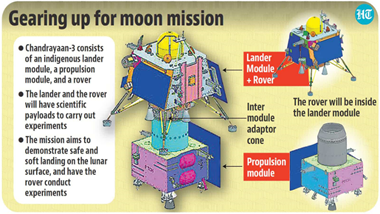

Context
The Indian Space Research Organisation (ISRO) launched Chandrayaan-3 to the Moon on a mission to attempt a soft landing on the lunar surface.
Key-highlights
- The spacecraft is currently cruising in space and is expected to reach lunar orbit by August 5 and the soft-landing attempt is likely to be on August 23.
- The spacecraft will cover the nearly 3,84,000 kilometers distance between the Earth and Moon in nearly 40 days, which is much longer than what the Apollo mission launched by Nasa would take.
What is Chandrayaan Mission?
- Chandrayaan-3 is a follow-on mission to Chandrayaan-2to demonstrate end-to-end capability in safe landing and roving on the lunar surface.
- Need:The need for Chandrayaan-3 arose after the unsuccessful landing of the Vikram lander during Chandrayaan-2.
- This new mission is designed to demonstrate the essential landing skills required for the proposed lunar polar exploration mission in 2024, which India intends to carry out in collaboration with Japan.
- Aim: The goal of the mission is to put India’s first lander (Vikram) and rover (Pragyan) on the lunar surface.
- Following in its predecessor’s footsteps, Chandrayaan-3 will attempt to land Vikramand Pragyan near the lunar south pole in hopes of using their respective scientific payloads for conducting in situ experiments, analysis, and observations to gain insights into the Moon’s composition.
- These include gaining insights into the:
- lunar surface composition
- presence of water ice in the lunar regolith
- the history of impacts on the Moon
- the Moon’s atmospheric evolution
- Global Elite: Mission makes India only the 4thnation after US, Russia and China to land on the moon.
- Launch Vehicle: The Chandrayana-3 mission was launched on India's heaviest rocket, the Launch Vehicle Mark-III.
|
The Vikram lander scientific payload consists of the:
The Pragyan rover scientific payload consists of the:
|

Composition
The Chandrayaan-3 spacecraft consists of three parts:
- Lander: The lander will be powered by four throttle-able engines and will feature a Laser Doppler Velocimeter (LDV).
- Rover: The rover will carry out chemical analysis of the lunar surface. Both the lander and the rover carry many scientific payloads for experiments on the lunar surface.
- Propulsion module: The propulsion module has one main function—to carry the lander and rover from “launch vehicle injection” to a 100-kilometre circular polar lunar orbit before it separates from the other modules.
Why is Chandrayaan-3 taking weeks to reach the cratered sphere?
|
Chandrayaan-3’s LVM-3
|
- While the Chandrayana-3 mission was launched on India's heaviest rocket, the Launch Vehicle Mark-III, it is still not strong enough to propel the mission on a direct path of the Moon. Hence, the longer journey.
- Clever use of gravity: In order to counter the lack of a powerful rocket, ISRO uses Earth's gravity to slingshot its way around the Moon, the same way as it used the slingshot around the planet to push the Mars Orbiter Mission (MoM) a.k.a Mangalyaan towards Mars.
- Chandrayaan-3 employs a series of Earth-bound maneuvers and lunar orbit insertion burns to gradually raise their orbits and synchronize with the Moon's orbit.
- These missions used a method called a series of "bi-elliptic transfers," which involved multiple engine burns to gradually increase the spacecraft's energy and adjust its trajectory.
- This method allows for more fuel-efficient and cost-effective missions but takes longer compared to the direct trajectory used by the Apollo missions.
|
In the case of Apollo missions, including Apollo 11, a direct trajectory called Translunar Injection (TLI) was used. The Saturn V launch vehicle propelled the Apollo spacecraft into Earth orbit first. |
Chandrayaan-3's mission is not just about reaching the Moon, it also aims to conduct scientific experiments to study the lunar environment, including its history, geology, and potential for resources. If all proceeds as planned, sometime around 23 August, Chandrayaan-3 will accomplish a groundbreaking feat as the first mission ever to successfully soft-land in the vicinity of the lunar south pole.


